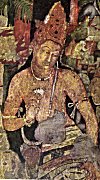9. Indian Art Synopsis art 162 honors
INDIAN ART

Shiva as Nataraja (Shiva as Lord of the Dance), bronze, ca.
1000 CE
The art of India primarily reflects the religious expression of the two major religions that developed within its region, Buddhism and Hinduism. As with many other other cultures, the artistic creativity expressed itself in religious-oriented sculpture, painting, and architecture. Iconographical representation of the Buddha, which didn't appear until the 2nd century CE, appears to be related to contact with Greek culture around that time; other Buddhist artistry appears in stupas, temples carved out of rock, low-relief symbols carved on architectural elements, and wall frescos painted in caves. Hindu art appears in temple architecture, temple carvings, and in paintings on paper, all in symbolic settings related to Hindu deities and theology. - DJB
Indian Art
TERMS:
Buddhism - The system of religion inaugurated by the Buddha (Siddhartha
Gautama (? - 544? BCE)) in India in the 6th century BCE (R-145)
Karma - (Sans., "action, fate"). In Buddhism and Hinduism,
the name given the results of action, especially the cumulative results
of a person's deeds in one stage of his existence as controlling his destiny
in the next...(R-539)
Nirvana - In Buddhist teaching,...enlightenment...(R-717)
Ashoka - Indian Emperor (272-232 BCE) and founder of Maurya dynasty (c.
322-184 BCE) (G9-428)
Stupa - cylindrical domed or conical shaped
earthen-filled structure representing a mountain that marks a shrine or
location where are buried relics of an important Buddhist monk
Chaitya - Buddhist temple carved out of rock
inside a hillside or mountain
Yaksha/Yakshi - nature spirits, male/female
spirit personifications of nature
Bodhisattva - (Sans., "being of wisdom"). In Buddhism
one who has attained the staus of a Buddha but who postpones his entry
to Buddahood in order to assist others in their quest for the truth. (R-117)
Vishnu/Krishna Shiva - two of the Hindu trinity of deities (Trimurti),
Krishna being an avatar, or incarnation, of Vishnu
Mudras - symbolic hand gesture
Nimbus - circle of flame surrounding a Hindu
deity
Gouache - heavy, opaque watercolor applied to paper
Mandapas - entrance hallway into sacred space
of Hindu temple
